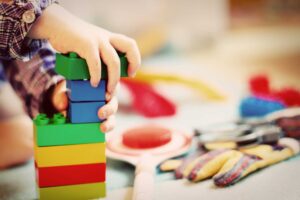
Child Development: Considerations for the Classroom
As teachers, we all understand the critical importance of considering a child’s developmental abilities when developing goals, objectives and learning activities. And of course, we also have seen first-hand that each of our students comes into the classroom with a range with their own abilities unique to their individual developmental trajectory. Some have an easier time waiting to be called on, while others blurt out whatever is on their minds. To others, holding a pencil is second nature, or they have been helped out at home; while for others, holding a pencil and other fine motor skills will take them a little longer. We would be hard pressed to ask the students who are in first grade to have the organizational skills of a third grader when transitioning from one activity to another. The same is true for writing: we may not be able to expect a kindergartener to be able to write all of their thoughts down, but they can certainly express them in other ways: through interactive play with their peers, through block building and hands-on activities, through talking and so much more.
Below, our veteran teachers talk about child development, sharing their ideas about setting expectations and meeting standards, all the while prioritizing learning for their students. We also focus on child development benchmarks to ensure developmentally appropriate expectations for students.

Recognizing and Coping with Stressors and Trauma in the Classroom
Key information about stress and trauma and how it might exhibit in preschool and elementary-age classrooms. We are also reminded of the care and support teachers need when working with (and worrying about) children who have experienced trauma and moderate or extreme stress. Geared for K-5 educators, this film is a must-watch for classroom teachers, as well as school administrators.

Cultivate Student Curiosity and Ingenuity In Small Ways Everyday
Curiosity and Invention come together to form ideas. How can we, in small ways, encourage both curiosity and invention in our classrooms? Author and educational psychologist Susan Engel, Ph.D., talks about creating space for conversation and questions in every day learning.

Creating Spaces for Ideas to Blossom in the Classroom
Ideas take time to develop, but everyone, including young people, has ideas–they just need the knowledge, space and encouragement to share them and put them into action. Schools can be essential settings for children to learn how to have ideas and grow them.

The Three I’s: Inquiry, Invention and Ideas for Improved Learning Experiences
Educational psychologist and author Susan Engel, Ph.D., shares her vision for schools: replace the three R’s with the three I’s. Inquiry, invention, and ideas are at the root of developing inquisitive, reflective and engaged life-long learners–and making school more fun for students and teachers alike.

Modeling Questions Shows Children How to Use their Curiosity to Explore and Learn
Developmental psychologist and author Susan Engel, Ph.D., talks about the role of adults in modeling curiosity and question asking.

Tools for Social and Emotional Support in the Classroom
Deb Vilas, child development expert and instructor at the Bank Street College of Education, shares with us some social and emotional support tools for teachers to use in the classroom. Tips include encouraging teachers to acknowledge and honor their own feels and helping children find their own unique talents.

What should we expect from a 5th grader?
There are academic, behavioral and social-emotional benchmarks we expect of our general education students, no matter the year, but fifth grade, in particular, brings about new expectations as students move from lower elementary to more focused academic work, classroom transitions, and the need for organization and multitasking, among other important skills.

Block building Incorporates Science, Math and All STEAM Disciplines
Block building incorporates learning in all areas of a child’s development – science, math, literacy, social studies, motor and social-emotional growth. In this piece, we’re going to focus on math and science, two important elements of STEM learning.

Water Play in Early Childhood
Children of all ages love to play in water–and there is so much to be gained from this fun, from fine motor skills and sensory exploration to developing language, science and math concepts.
The Importance of Play for a Child's Development
Seedlings Workshop Director Judy Cuthbertson talks about the importance of integrating play and childhood development principals when developing classroom activities for young students. With the demands and realities of today’s classroom some of learning’s most critical components can buried or rushed, but there are short activities that can make life-long imprints in building a love of learning and foundations in math, science, art, critical thinking, and more.
